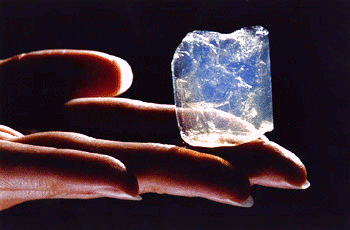Holy Smoke!? The World’s Mightiest Gas Jelly

Aerogel, also known as frozen smoke, is composed of 99.98% of air.(Photo credits to Evan Ackerman on Dvice.com)
No, I’m not kidding. This is literally the world’s most powerful gas jelly. Discovered in the 1930’s, Aerogel is now the second lightest material on our planet (the lightest is currently aerographite, discovered by Germany researchers in 2011). Not only it is lighter than air, it can support materials that are thousand times heavier than its own weight. Comes in a variety of shapes and colors, aerogel is used extensively in many industries including engineering, cosmetics and space science research. Renowned for being the best insulator in the world, the silica aerogel currently holds 15 entries in the Guinness World Records, and is 1000 times less dense than glass.
BIRTH OF THE JELLY

Steven Kitsler, born on March 26,1900, is known as the father of Aerogels. (Photo credits to Google.ca)
It all started with a bet back in 1930’s. Steven Kitsler, an American Scientist, accepted a challenge from Charles Learned “to see if they could replace the liquid inside of a jelly jar without causing any shrinkage” (Stone 1999). The very first aerogel was produced from extracting the liquid component of silica gels, through a precise controlled method called Supercritical drying. Basically the gel is heated and condensed in a tank, until all liquids (both water and alcohol) are drained and the cube is displaced with air. A small piece of aerogel is practically impossible to see or feel, but the surface texture resembles styrofoam if you decide poke or hold it between your fingers.
FLAVORS OF THE JELLY
Silica Aerogel
This is the most common aerogel you’ll see. As mentioned earlier, the silica aerogel is the best insulator in the world. It has an extremely low thermal conductivity which makes it super effective in blocking heat, especially infrared radiation. Commercial uses include incorporation of the gel into solar panels, which allows sunlight to enter buildings and warm up the interior without turning any heat on! Also, NASA uses silica-based aerogels to develop thermal space suits and collect tiny space dust particles on spacecrafts.
Carbon Aerogel
This aerogel is mostly made from organic polymers, threaded tightly by covalent bonds. It is much less fragile than the inorganic ones, such as silica aerogels, and has a significantly large surface area. Depending on their density, these organic jellies can conduct electricity very well, and are commonly used to produce supercapacitors. Capacitors are condensers found in batteries of cameras or large engines used to store electrical energy. Also, since carbon aerogels fall on the darker side of the visible spectrum, they are usually very efficient in trapping solar energy, just like the silica ones.
Metal Oxide Aerogels

Metal aerogels with assorted colors and sizes. (Photo credit to Google.ca)
These are like Skittles and come with the rainbow. Due to the fact that they are made from metals, they can be used to catalyze chemical reactions and serve as a matrix for explosives. In addition, they are mostly magnetic and may be used to trap hypervelocity particles from outer space.
Here are two interesting videos featuring the Jelly:
References:
Images:
http://dvice.com/archives/2010/12/11-cheap-gifts.php/
http://www.aerogel.org/wp-content/uploads/2009/02/lanthanide_oxide_aerogels.jpg
Websites:
http://dornob.com/aerogel-see-through-strong-as-steel-ligher-than-air/
Steven Kitsler:
http://en.wikipedia.org/wiki/Samuel_Stephens_Kistler
Quote:
Stone, Mike (1999). “Aerogel FAQs”. Archived from rogel/faq.html”>the original on 2008-03-24. Retrieved 2012-09-23.
